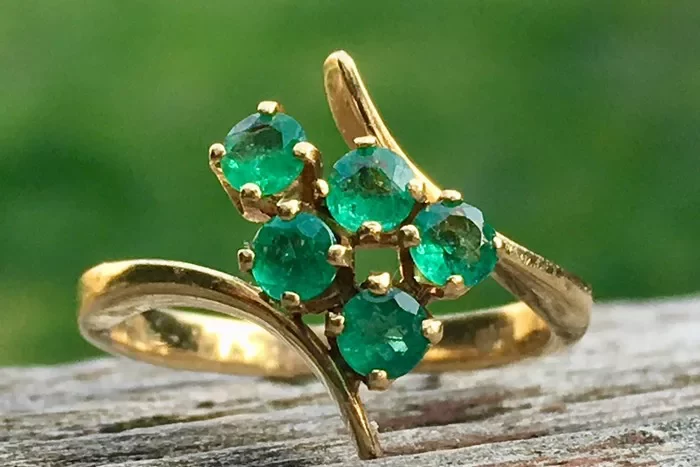Emeralds, one of the most coveted gemstones in the world, have captivated humanity for centuries with their mesmerizing green hues and captivating beauty. Belonging to the beryl family, alongside gems like aquamarine and morganite, emeralds stand out for their rarity, unique features, and rich cultural significance.
Emeralds owe their allure primarily to their striking green coloration, which ranges from delicate pastel greens to deep, vivid shades reminiscent of lush rainforests or the depths of the ocean. Their rarity is partly due to the geological conditions required for their formation, typically found in metamorphic rocks where beryllium and chromium combine under immense pressure and heat.
Factors Influencing Emerald Value:
Color: The color of an emerald is the single most significant factor influencing its value. The ideal emerald possesses a pure green hue with intense color saturation. Deeper and more vibrant greens are highly prized, often fetching premium prices in the market. Emeralds with a bluish or yellowish secondary hue may be less valuable, depending on the intensity of the color and market trends.
Clarity: Unlike diamonds, emeralds often contain visible inclusions, commonly referred to as “jardin” or “gardens,” which resemble tiny fissures or fractures. These inclusions are sometimes called “fingerprints” due to their unique patterns. While too many inclusions can detract from the gem’s beauty, some degree of clarity characteristic to natural emeralds is accepted and even valued as proof of authenticity. However, emeralds with fewer inclusions and clearer transparency command higher prices.
Cut: The craftsmanship of the cut significantly impacts an emerald’s value. A well-cut emerald enhances its color, brilliance, and overall appeal. Skilled lapidaries strive to maximize the stone’s beauty while minimizing the visibility of any inclusions. Precise cutting techniques such as the emerald cut, which highlights the gem’s color and clarity, can greatly enhance its value.
Carat Weight: Similar to other gemstones, the carat weight of an emerald influences its value. Larger emeralds are rarer and thus command higher prices per carat compared to smaller stones. However, the overall value of an emerald is not solely determined by its size but also by its color, clarity, and cut.
Price Ranges:
Emeralds span a wide range of prices depending on their quality, size, and market demand. Here are some general price ranges to provide an overview:
Average Price: Emeralds of standard quality typically range from $50 to $1,000 per carat. These stones may exhibit moderate color saturation, clarity, and cut.
High-Quality Green Emeralds: Exceptional emeralds with vivid, intense green hues and excellent clarity can fetch prices ranging from $150 to $20,000 per carat or even higher for extraordinary specimens. These top-tier emeralds are highly sought after by collectors and connoisseurs.
Rough Emeralds: Rough emeralds, in their natural state before cutting and polishing, also vary in price. Standard quality rough emeralds typically range from $30 to $300 per carat for small samples. The value of rough emeralds depends on factors such as size, color, clarity, and potential for yield after cutting.
Cultural Significance and Symbolism:
Beyond their monetary value, emeralds hold profound cultural significance and symbolism across various civilizations:
Rare and Reminiscent of Lush Environments: Emeralds are often associated with lush green landscapes, symbolizing renewal, vitality, and abundance. Their deep green hues evoke images of verdant forests, captivating the imagination with their natural beauty and mystique.
Symbol of Life, Growth, and Prosperity: In many cultures, emeralds symbolize life, growth, and prosperity. Ancient civilizations believed that emeralds possessed mystical powers and bestowed their wearers with good fortune, fertility, and protection. In mythology, emeralds were often associated with goddesses of nature and fertility, further emphasizing their connection to life-affirming forces.
How to Get an Appraisal:
For individuals seeking to determine the value of their emeralds, obtaining a professional appraisal is essential. Here are some steps to consider:
Find a Qualified Appraiser: Seek out a certified gemologist or experienced appraiser specializing in colored gemstones, particularly emeralds. Look for credentials from reputable gemological organizations such as the Gemological Institute of America (GIA) or the American Gem Society (AGS).
Arrange for an Evaluation: Schedule an appointment with the appraiser to have your emerald evaluated. Bring any documentation or certificates of authenticity you may have, as well as information regarding the gem’s origin, if available.
Assess the Gem’s Characteristics: During the appraisal, the appraiser will examine various aspects of the emerald, including its color, clarity, cut, and carat weight. They may also use specialized equipment such as microscopes and spectrometers to analyze the gem’s properties.
Receive a Written Appraisal Report: Upon completion of the evaluation, the appraiser will provide you with a detailed appraisal report outlining the gem’s characteristics and estimated value. This document can be used for insurance purposes, estate planning, or when buying or selling the emerald.
In conclusion, the value of emeralds transcends mere monetary worth, encompassing their rarity, beauty, and cultural significance. Understanding the factors that influence emerald valuation empowers individuals to make informed decisions when acquiring, selling, or investing in these captivating gemstones. By seeking professional appraisals and appreciating the rich history and symbolism of emeralds, enthusiasts can fully appreciate the enduring allure of these timeless treasures.


